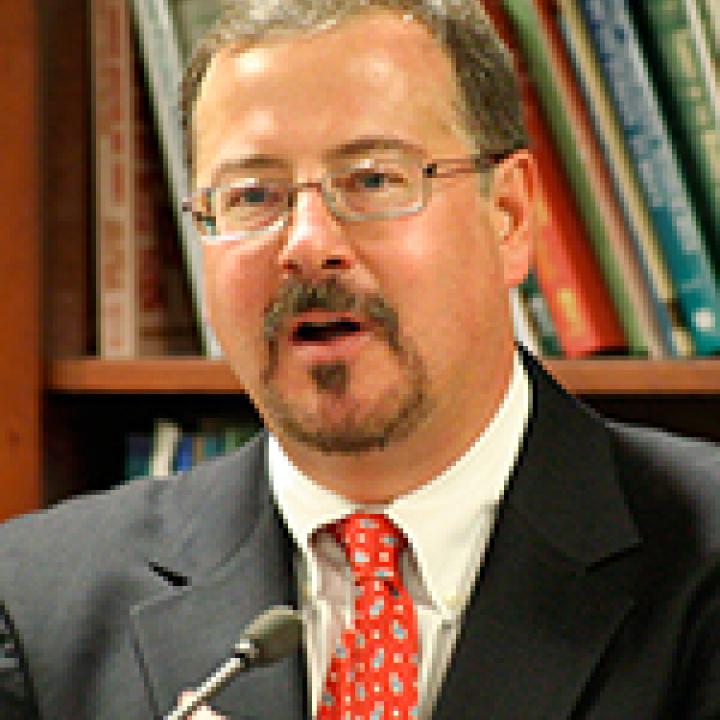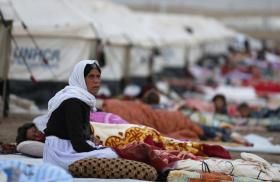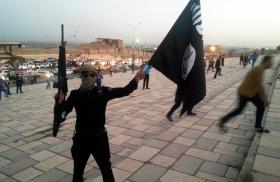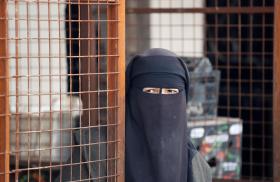
- Policy Analysis
- Counterterrorism Lecture
Assessing the Fight against al-Qaeda

Part of a series: Counterterrorism Lecture Series
or see Part 1: U.S. Efforts against Terrorism Financing: A View from the Private Sector
How does the U.S. government view the status of the global fight against al-Qaeda in mid 2008?
On August 12, 2008, U.S. national intelligence officer (NIO) for transnational threats Ted Gistaro addressed a Washington Institute Policy Forum. Mr. Gistaro was appointed NIO in November 2006 after nearly two decades of service with the Central Intelligence Agency. The following is the prepared text of his remarks.
We assess that greatly increased worldwide counterterrorism efforts over the past five years have constrained the ability of al-Qaeda to attack the United States and our allies and have led terrorist groups to perceive the homeland in particular as a harder target to strike than on September 11. These security measures have helped disrupt known plots against the United States since September 11. That said, al-Qaeda remains the most serious terrorist threat to the United States, and we remain in the heightened threat environment we noted in the July 2007 National Intelligence Estimate.
• We are not aware of any specific, credible al-Qaeda plot to attack the U.S. homeland. But we do receive a steady stream of threat reporting from sources of varying creditability, which the U.S. intelligence community is investigating aggressively.
• As the election nears, we expect to see an uptick in such threat reporting -- of varying credibility -- regarding possible attacks.
• We also expect to see an increase in al-Qaeda's propaganda efforts, especially around the anniversary of the attacks of September 11, 2001, which has often been a hook for such propaganda statements. In Osama bin Laden's September 2007 address to the "American people," he labeled the democratic system "a failure." He claimed that there is no difference between Democratic or Republican candidates winning presidential or congressional elections so long as "big corporations" support candidates.
We assess that al-Qaeda's intent to attack the U.S. homeland remains undiminished. Attack planning continues and we assess it remains focused on hitting prominent political, economic, and infrastructure targets designed to produce mass casualties, visually dramatic destruction, and significant economic and political aftershocks. • In his September 2007 statement, bin Laden said that American citizens cannot be considered "innocent" because they are complicit in their government's policies. He called for Americans to convert to Islam, and warned that the solution "is to continue to escalate the killing and fighting against you."
• The group is proficient with conventional small arms and improvised explosive devices, and is innovative in creating new capabilities and overcoming security obstacles.
• We assess that al-Qaeda will continue to try to acquire and employ chemical, biological, radiological, or nuclear material in attacks, and would not hesitate to use them if it develops what it deems is a sufficient capability.
In spite of successful U.S. and allied operations against al-Qaeda, especially the death of important al-Qaeda figures since December, the group has maintained or strengthened key elements of its capability to attack the United States in the past year.
• First, al-Qaeda has strengthened its safe haven in Pakistan's Federally Administered Tribal Areas (FATA) by deepening its alliances with Pakistani militants and pushing many elements of Pakistani government authority from the area. It now has many of the operational and organizational advantages it once enjoyed across the border in Afghanistan, albeit on a smaller and less secure scale.
• Second, despite some significant losses, al-Qaeda has replenished its bench of skilled mid-level lieutenants capable of directing its global operations. These losses collectively represent the most serious blow to al-Qaeda's leadership since 2005.
• While it sometimes can take several months to replace these individuals, al-Qaeda has developed succession plans, can reshuffle leadership responsibilities, and promote younger commanders with years of battlefield experience to senior positions. The leaders' collocation in the FATA allows them to manage the organization collaboratively, helping facilitate the replacement of key figures.
• Third, bin Laden and his deputy, Ayman al-Zawahiri, continue to maintain al-Qaeda's unity and its focus on their strategic vision and operational priorities, although security concerns likely preclude them from running the organization day-to-day. Bin Laden remains al-Qaeda's authoritative source for strategic and tactical guidance. Subordinates continue to see him as the group's most inspirational force.
• Fourth, al-Qaeda is identifying, training, and positioning operatives for attacks in the West, likely including in the United States. These operatives include North American and European citizens and legal residents with passports that allow them to travel to the United States without a U.S. visa.
Al-Qaeda's ability to establish and manage links to other affiliated terrorist groups and facilitation networks is a key indicator of its organizational health. These links help bolster its operational and propaganda reach.
• Despite setbacks in Iraq, al-Qaeda in Iraq (AQI) remains al-Qaeda's most prominent and lethal regional affiliate. While al-Qaeda leaders likely see the declining effectiveness of AQI as a vulnerability to their global recruiting and fundraising efforts, they likely continue to see the fight in Iraq as important to their battle with the United States. Bin Laden and al-Zawahiri since late 2007 have issued eight statements to rally supporters, donors, and prospective fighters by publicly portraying the Iraq jihad as part of a wider regional cause to "liberate" Jerusalem.
• Since early 2006, Pakistani militant groups have increased their collaboration with al-Qaeda. This includes ethnic Pashtun groups native to the FATA and groups from eastern Pakistan, most of whom previously focused on attacking Indian-held Kashmir. While a major focus of these groups is conducting attacks against coalition forces in Afghanistan, they provide safe haven to al-Qaeda fighters, collaborate on attacks inside of Pakistan, and support al-Qaeda's external operations, including against the West.
• In September 2006, al-Qaeda consolidated jihadist forces in North Africa under its banner by merging Algerian and later Libyan terrorist groups into al-Qaeda in the Islamic Maghreb (AQIM). AQIM has continued to focus on Algerian government targets. But since the merger, AQIM has conducted at least eight attacks against Western interests in the region, including two simultaneous suicide car bomb attacks in Algiers in December -- including one against the UN building that killed nearly seventy people. AQIM is training growing numbers of operatives from every country in the Maghreb and the Sahel.
• In the Middle East, al-Qaeda has focused on rebuilding its operational, facilitation, and funding networks that have been damaged by our allies in the region. In Saudi Arabia, authorities continue to detain al-Qaeda linked extremists, highlighting both the threat and the kingdom's commitment to combating it. Yemen is rapidly reemerging as a jihadist battleground and potential base of operations. A March mortar attack against the U.S. embassy and two attacks against the president's compound in late-April underscore the al-Qaeda threat there.
• In East Africa, senior terrorists responsible for the 1998 U.S. embassy bombings and the 2002 attacks in Mombasa, Kenya, remain at large, and are likely trying to merge with local extremists under al-Qaeda's banner.
Al-Qaeda is working to motivate more "homegrown" extremists -- radicals who are inspired, but not directed, by the group -- to plan attacks inside the United States. Though difficult to measure, the spread of radical Salafist internet sites that provide religious justification for attacks, violent anti-Western rhetoric, and signs that self-generating cells in the United States identify with bin Laden's violent objectives all suggest a small number of individuals here may radicalize to the point that they consider conducting violent attacks.
• A growing portion of al-Qaeda propaganda is in English and aimed at an American audience -- either in translated form or verbally by American al-Qaeda members. One such member publicly urged Muslims in early January to violently protest the president's Middle East trip.
• Bin Laden's September 2007 message and al-Zawahiri's May 2007 interview include specific U.S. cultural and historical references almost certainly meant to strike a chord with disaffected U.S. listeners.
Yet even as al-Qaeda attempts to push its propaganda in the West, its support has suffered several setbacks among its key constituents. Al-Qaeda's brutal attacks against Muslim civilians are tarnishing its image among both mainstream and extremist Muslims. In 2007, extremist violence claimed more than 9,500 noncombatant victims in Muslim countries.
• Over the past year, some hardline religious leaders and extremists who once had significant influence with al-Qaeda have publicly criticized it, including Sayyid Imam Abd al-Aziz al-Sharif, a jailed Egyptian terrorist who once saved bin Laden's life, and Saudi cleric Sheikh Salman al-Awdah, whom bin Laden credits as a leading ideological influence.
• Al-Qaeda senior leaders in 2008 have devoted nearly half their airtime to defending the group's legitimacy. This defensive tone continues a trend observed since at least last summer and reflects concern over allegations by militant leaders and religious scholars that al-Qaeda and its affiliates have violated the Islamic laws of war, particularly in Iraq and North Africa.





